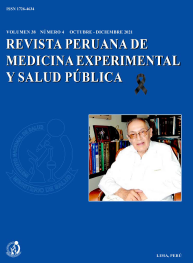Revista de revistas
![]()
PUBLICACIONES DE INVESTIGADORES DEL INS EN REVISTAS INDIZADAS
Marzo
REVISTAS INTERNACIONALES
1. Leite JA, Resende P, Araya JL, Barrera GB, Baumeister E, Caicedo AB, Otarola-Mayhua1 J, Motta F, Huaringa-Nuñez M1 et al. Genetic evolution of influenza viruses among selected countries in Latin America, 2017–2018. PLoS ONE 15(3): e0227962. http://sci-hub.tw/10.1371/journal.pone.0227962 Available from: https://journals.plos.org/plosone/article?id=10.1371/journal.pone.0227962
ABSTRACT
/a08fig01.jpg)
Objective. Since the 2009 influenza pandemic, Latin American (LA) countries have strengthened their influenza surveillance systems. We analyzed influenza genetic sequence data from the 2017 through 2018 Southern Hemisphere (SH) influenza season from selected LA countries, to map the availability of influenza genetic sequence data from, and to describe, the 2017 through 2018 SH influenza seasons in LA. Methods.
We analyzed influenza A/H1pdm09, A/H3, B/Victoria and B/Yamagata hemagglutinin sequences from clinical samples from 12 National Influenza Centers (NICs) in ten countries (Argentina, Brazil, Chile, Colombia, Costa Rica, Ecuador, Mexico, Paraguay, Peru and Uruguay) with a collection date from epidemiologic week (EW) 18, 2017 through EW 43, 2018. These sequences were generated by the NIC or the WHO Collaborating Center (CC) at the U.S Centers for Disease Control and Prevention, uploaded to the Global Initiative on Sharing All Influenza Data (GISAID) platform, and used for phylogenetic reconstruction.
Findings. Influenza hemagglutinin sequences from the participating countries (A/H1pdm09 n = 326, A/H3 n = 636, B n = 433) were highly concordant with the genetic groups of the influenza vaccine-recommended viruses for influenza A/H1pdm09 and influenza B. For influenza A/H3, the concordance was variable.
Conclusions. Considering the constant evolution of influenza viruses, high-quality surveillance data—specifically genetic sequence data, are important to allow public health decision makers to make informed decisions about prevention and control strategies, such as influenza vaccine composition. Countries that conduct influenza genetic sequencing for surveillance in LA should continue to work with the WHO CCs to produce high-quality genetic sequence data and upload those sequences to open-access databases.
2 Khanam S, Patel NB, O’Neil L, Obregon-Tito A, Tito R, Guija E, Troncoso L, Martin L2, Warinner C, Lewis CM, Sankaranarayanan K. Genomic and phenotypic diversity of antibiotic resistant Escherichia coli isolated from the gut microbiome of non-industrial populations. AMERICAN JOURNAL OF PHYSICAL ANTHROPOLOGY 171 sup.69: 141. https://onlinelibrary.wiley.com/doi/epdf/10.1002/ajpa.24023
/a08fig02.jpg)
Abril
REVISTAS INTERNACIONALES
/a08fig03.jpg)
1. Aguirre Quispe W1. Estudios clínicos controlados y eficacia: a propósito de una investigación en neurocirugía Controlled clinical trials and efficacy: Report of a neurosurgical study. Neurología 35(2): 136-137 https://doi.org/10.1016/j.nrl.2017.09.020. Available from: https://www.sciencedirect.com/science/article/pii/S0213485317303687?via%3Dihub
2. Moreno J, Duarte C, Cassiolato AP, Morales S1 et al. Molecular characterization of Latin American invasive Streptococcus pneumoniae serotype 19A isolates. Vaccine 38(19):3524-3530. https://doi.org/10.1016/j.vaccine.2020.03.030. Available from: https://www.sciencedirect.com/science/article/pii/S0264410X20303856?via%3Dihub#!
ABSTRACT
/a08fig04.jpg)
Streptococcus pneumoniae is a major cause of morbidity and mortality worldwide, especially among children and the elderly. S. pneumoniae serotype 19A has emerged as a major cause of invasive disease in many countries, regardless of whether pneumococcal conjugate vaccines are used. The aim of this study was molecular characterization of invasive S. pneumoniae serotype 19A isolates recovered between 2000 and 2015 from 13 National Laboratories through the laboratory-based surveillance of invasive S. pneumoniae program SIREVA II in Latin American countries. The isolates were submitted with antimicrobial susceptibility tests and were genotyped by a combination of pulsed field gel electrophoresis (PFGE) and multilocus sequence typing (MLST). Of the 185 isolates assayed, notable rates of resistance to penicillin (MIC ≥ 0.125 µg/mL; 68.6%), tetracycline (63.7%), trimethoprim-sulfamethoxazole (63.2%), and erythromycin (43.2%) were observed, while 44.3% of isolates were multidrug resistant. The most frequently observed sequence types (ST) were ST320 (32.4%), ST199 (14.1%), ST172 (10.8%) and ST5204 (7.1%). The distribution of STs indicated regional differences in the epidemiology of the clonal groups. The present study showed a diverse genetic background of the pneumococcal population in Latin American countries. Continuous surveillance of the pneumococcal serotype 19A population in the region will be necessary to obtain information about geographical differences and changes in the spread and the establishment of particular clones.
Keywords: Streptococcus pneumoniae, Invasive pneumococcal disease, Latin America, Serotype 19A, Laboratory surveillance
3. Solari L1, Santos-Lazaro D1, Puyen Zully M1. Mutations in Mycobacterium tuberculosis Isolates with Discordant Results for Drug-Susceptibility Testing in Peru. Int J Microbiol. 2020:8253546. Published 2020 Apr 6. doi:10.1155/2020/8253546.
Disponible en: https://www.ncbi.nlm.nih.gov/pmc/articles/PMC7166257/#__ffn_sectitle
ABSTRACT
/a08fig05.jpg)
Evaluation of resistance to antituberculosis drugs is routinely performed with genotypic or phenotypic methods; however, discordance can be seen between these different methodologies. Our objective was to identify mutations that could explain discordant results in the evaluation of susceptibility to rifampicin and isoniazid between molecular and phenotypic methods, using whole genome sequencing (WGS). Peruvian strains showing sensitive results in the GenoType MTBDRplus v2.0 test and resistant results in the proportions in the agar-plaque test for isoniazid or rifampin were selected.
Discordance was confirmed by repeating both tests, and WGS was performed, using the Next Generation Sequencing methodology. Obtained sequences were aligned “through reference” (genomic mapping) using the program BWA with the algorithm “mem”, using as a reference the genome of the M. tuberculosis H37Rv strain. Discordance was confirmed in 14 strains for rifampicin and 21 for isoniazid, with 1 strain in common for both antibiotics, for a total of 34 unique strains. ‘e most frequent mutation in the rpoB gene in the discordant strains for rifampicin was V170F. ‘e most frequent mutations in the discordant strains for isoniazid were katG R463L, kasA G269S, and Rv1592c I322V. Several other mutations are reported. ‘is is the first study in Latin America addressing mutations present in strains with discordant results between genotypic and phenotypic methods to rifampicin and isoniazid. ‘ese mutations could be considered as future potential targets for genotypic tests for evaluation of susceptibility to these drugs.










